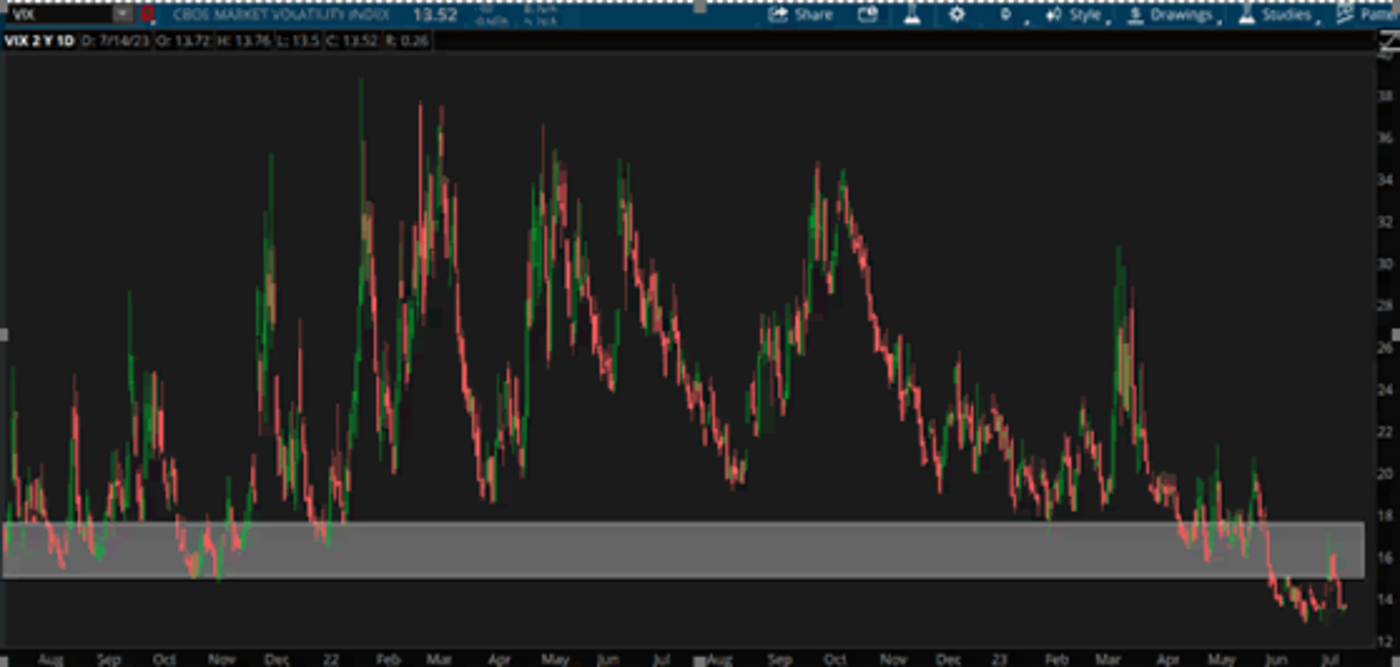(Monday market open) Earnings season spreads its wings this week with reports from several giant banks and a mega-cap company on the schedule, along with a dose of consumer-oriented retail sales and housing data.
Today’s calendar is light, but things liven up the next few days as American Airlines (NASDAQ:AAL), Tesla (NASDAQ:TSLA), Bank of America (NYSE:BAC), Morgan Stanley (MS), Philip Morris (NYSE:PM), Netflix (NASDAQ:NFLX), American Express (NYSE:AXP), Johnson & Johnson (JNJ), United Airlines (UAL), and CSX (NASDAQ:CSX) all get ready to report later in the week.
The Q2 earnings period is off to a strong start, with 10 of the 12 S&P 500 companies reporting last week surpassing analysts’ expectations. However, as we’ve noted, Wall Street’s expectations are on the soft side. Simply beating analysts’ estimates may not be enough to drive stocks higher–especially as the market enters earnings season at its highest valuation level since early 2022.
On Friday, the S&P 500 Index (SPX) and NASDAQ Composite (COMP) closed lower after strong opens, possibly reflecting preweekend profit-taking. Even so, the market had a solid week with a gain of 2.4% for the S&P 500, and a nice cross-section of different sectors played a role. Communication services, consumer discretionary, real estate, and info tech are among the recent leaders, representing a mix of cyclical stocks, which tend to rise in a strong economy, and more defensive ones.
The Equal-Weight S&P 500 Index (SPXEW), which strips market capitalization from the index weighting, roughly kept pace with the SPX last week–a sign that this isn’t a one-dimensional move driven by mammoth info tech stocks. The biggest of them all, Apple (NASDAQ:AAPL), gained exactly one penny last week, though other mega-caps like Nvidia (NASDAQ:NVDA) and Microsoft (NASDAQ:MSFT) continued to roll along.
Morning rush
- The 10-year Treasury note yield (TNX) inched down to 3.78% and fell 23 basis points last week, giving stocks a tailwind.
- The U.S. Dollar Index ($DXY) remained below 100 at 99.87.
- Cboe Volatility Index® (VIX) futures rose to 13.96.
- WTI Crude Oil (/CL) fell to $74.42 per barrel.
Just in
China’s Q2 Gross Domestic Product (GDP) report hit the tape early Monday and was a lower-than-expected 6.3%. Analysts had forecast 7.3% year-over-year growth, a large number that partly reflected easy comparisons to the same quarter a year ago, when Shanghai and other cities were shut down and overall growth was weak.
The 6.3% sounds decent on paper, but it is a disappointing increase of just 0.8% from Q1. Declining exports and weak consumer spending hurt, along with softness in the real estate market. A Chinese economist called the economy “quite weak,” the New York Times reported. This could be bad news for energy company stocks if falling demand from China is hurting crude oil prices. It also could put pressure on Beijing to provide more economic stimulus.
Eye on the Fed
Futures trading indicates a 96% probability that the Federal Open Market Committee (FOMC) will raise interest rates by 25 basis points at its meeting next week, according to the CME FedWatch Tool. Chances of a follow-up September hike stand at 11%, and the market expects the July hike to be the last of the year, putting the probability of that near 80%.
Lower inflation in last week’s data suggests the Fed could consider ending its rate-hike cycle, but that wouldn’t necessarily mark the beginning of a cut cycle, says Collin Martin, a director of fixed income strategy at the Schwab Center for Financial Research. With many indicators still highlighting the economy’s resilience, the Fed is unlikely to cut rates any time soon. A rate cut would be a form of stimulus that could rekindle inflationary pressures, which is the last thing the Fed wants. Hawkish remarks from several Fed speakers last week reinforce that view.
Fed speaker activity will die down in coming days ahead of next week’s FOMC meeting.
What to Watch
Aside from earnings, the keystone this week is June Retail Sales, due Tuesday morning. Analysts expect a bump to 0.5% in June from 0.3% in May, according to Trading Economics. Monthly Retail Sales have been all over the map since late last year, inching up the last two months after falling in four of the previous five.
One number to watch is Retail Sales excluding automobiles, which rose just 0.1% in May. Another item to check could be food service and drinking place sales, which rose 0.4% in May and might have remained firm in June considering low unemployment and rising wages. The services economy continues to drive inflation growth.
Speaking of inflation, Friday’s preliminary July University of Michigan Consumer Sentiment showed one-year inflation expectations adding a notch to 3.4%, from 3.3% in June. Don’t rule out a possible downward adjustment to the preliminary inflation reading when the final appears later this month, however, considering recent positive inflation data.
June Housing Starts and Building Permits are due out Wednesday morning.
Stocks in Spotlight
Bank parade: Today’s calendar is light on earnings following solid hits from three of the biggest banks last Friday morning and a nice contribution from UnitedHealthcare (UNH). The basepaths get crowded again tomorrow morning when Bank of America, Morgan Stanley, and Lockheed Martin (NYSE:LMT) are expected to report.
Like other banks, Bank of America received a tailwind from net interest income in Q1, and it wouldn’t be shocking to see that continue in Q2 based on the path of rates. Deposits fell sequentially in Q1, but they might see an upswing in Q2 as big banks potentially benefited from turmoil at smaller institutions.
Smaller regional banks that still may be struggling with fallout from that turmoil are also set to report later this week. Their loan and deposit progress could shed light on the underlying economy, particularly small businesses and their employees who depend on those banks for funding.
Military time: Lockheed Martin hasn’t participated much in this year’s rally, but the company appeared to get a boost last week from news that the United States may be ready to sell a batch of F-16 fighter planes to Turkey. Keep an eye on new equipment orders, which were light in Q1.
Pickup wars: Ford (F) announced price cuts of as much as $10,000 on its electric F-150 Lightning pickups this morning. This came just a day after Tesla announced its first electric pickup has been built. CNBC reported that Rivian’s (RIVN) growing sales of its electric trucks also may have played into Ford’s price cut decision.
Earnings outlook: S&P 500 companies are expected to report a cumulative 7.1% year-over-year earnings decline in Q2, according to FactSet. So far, 6% of S&P 500 companies have reported, and 80% of those surpassed the average Wall Street EPS estimate—but just 63% exceeded estimates for revenue, FactSet reported.

CHART OF THE DAY: HOW LOW CAN YOU GO? The Cboe Volatility Index (VIX—candlesticks) is back to historic lows as investors become increasingly bullish on the markets. However, extreme lows on the VIX are also seen by many investors of a sign of complacency and therefore a sign of caution. However, prior to 2020, the VIX consistently traded at these levels and in 2017, even lower. So, “low” on the VIX is often a question of relativity and you have to decide what context you want to choose. Data source: Cboe. Chart source: The thinkorswim® platform from TD Ameritrade. For illustrative purposes only. Past performance does not guarantee future results.
Thinking cap
Ideas to mull as you trade or inves
Valuation consideration: As mentioned above, the S&P 500 trades at its highest valuation since early 2022, near 20 on a forward price-earnings (P/E) basis. However, if you strip out the so-called Magnificent Seven stocks at the very top that together form roughly 25% of the index’s market capitalization, the P/E falls to near 15, much more “normal” on a historic basis. It’s evidence that the high-flyers are distorting perceptions of the overall market. Investors would be wise to drill down and track sectors for a better sense of actual performance and value.
Dial for dollars: The Dollar Index dipped below 100 last week for the first time since April 2022 as investors hoped for easier Fed policy. If the dollar remains soft, it could power second-half growth for many large multinational U.S. companies by reducing the cost of their products for overseas customers and fueling increased demand. The Dollar Index reached nearly 115 in late 2022 and turned into a headwind for many firms, especially those in info tech—which is heavily exposed to overseas markets—from late 2022 into mid-2023. A softer greenback could potentially help tech enjoy a second wind after the long rally, though currency is arguably one small factor among many. Other sectors with heavy overseas exposure that might benefit include materials, communication services and consumer staples.
Japanese engine: Despite a weaker-than-expected Producer Price Index report from Japan last week, consumer inflation there remains higher than in the United States at 3.2% year-over-year (versus the U.S. rate of 3.1%). This is a rare event, notes Jeffrey Kleintop, Schwab’s chief global investment strategist, and comes as Japan’s stock market outperformed all others so far this year. Strong consumption in Japan could help countries it imports from, led by China, the United States, Australia, and Saudi Arabia, according to United Nations data. The last time Japan’s consumer inflation topped U.S. inflation for an extended stretch was in 2014–2015, according to Trading Economics.
Calendar
July 18: June Retail Sales and expected earnings from Bank of America (BAC), Morgan Stanley (MS), Lockheed Martin (LMT), and PNC (PNC)
July 19: June Housing Starts and Building Permits, and expected earnings from Goldman Sachs (NYSE:GS), Netflix (NFLX), First Horizon (NYSE:FHN), Haliburton (HAL), and U.S. Bancorp (USB)
July 20: June Existing Home Sales, June Leading Indicators, and expected earnings from Abbott Labs (NYSE:ABT), American Airlines (AAL), Philip Morris (PM), Johnson & Johnson (JNJ), D.R. Horton (DHI), Freeport McMoran (FCX), Travelers (NYSE:TRV), and CSX (CSX)
July 21: Expected earnings from American Express (AXP), AutoNation (NYSE:AN), and Regions Financial (NYSE:RF)
July 24: Expected earnings from Domino’s Pizza (DPZ)

Disclosure: TD Ameritrade® commentary for educational purposes only. Member SIPC. Options involve risks and are not suitable for all investors. Please read Characteristics and Risks of Standardized Options.
